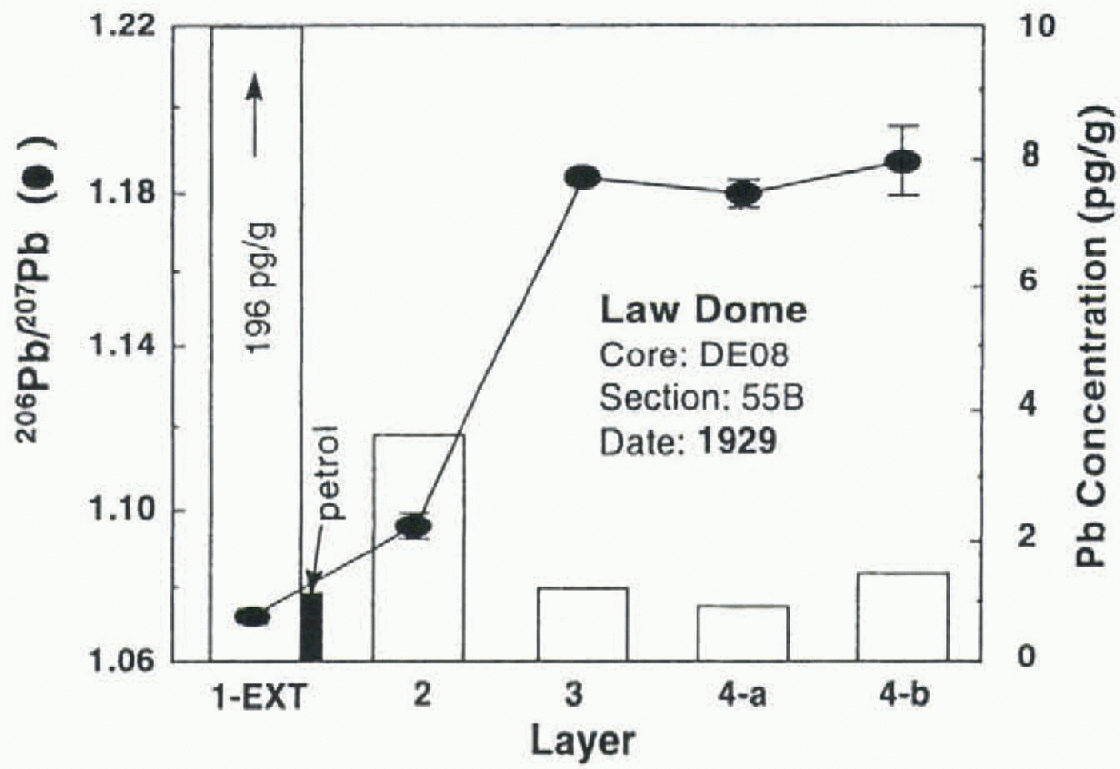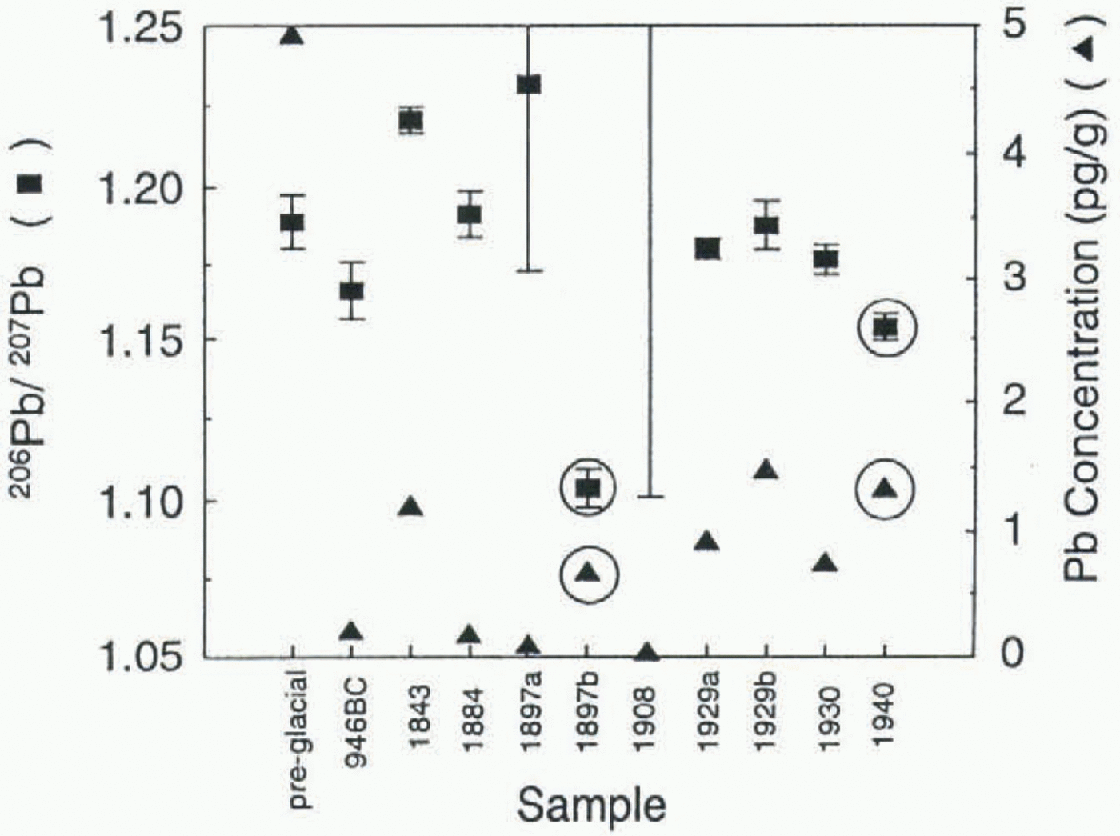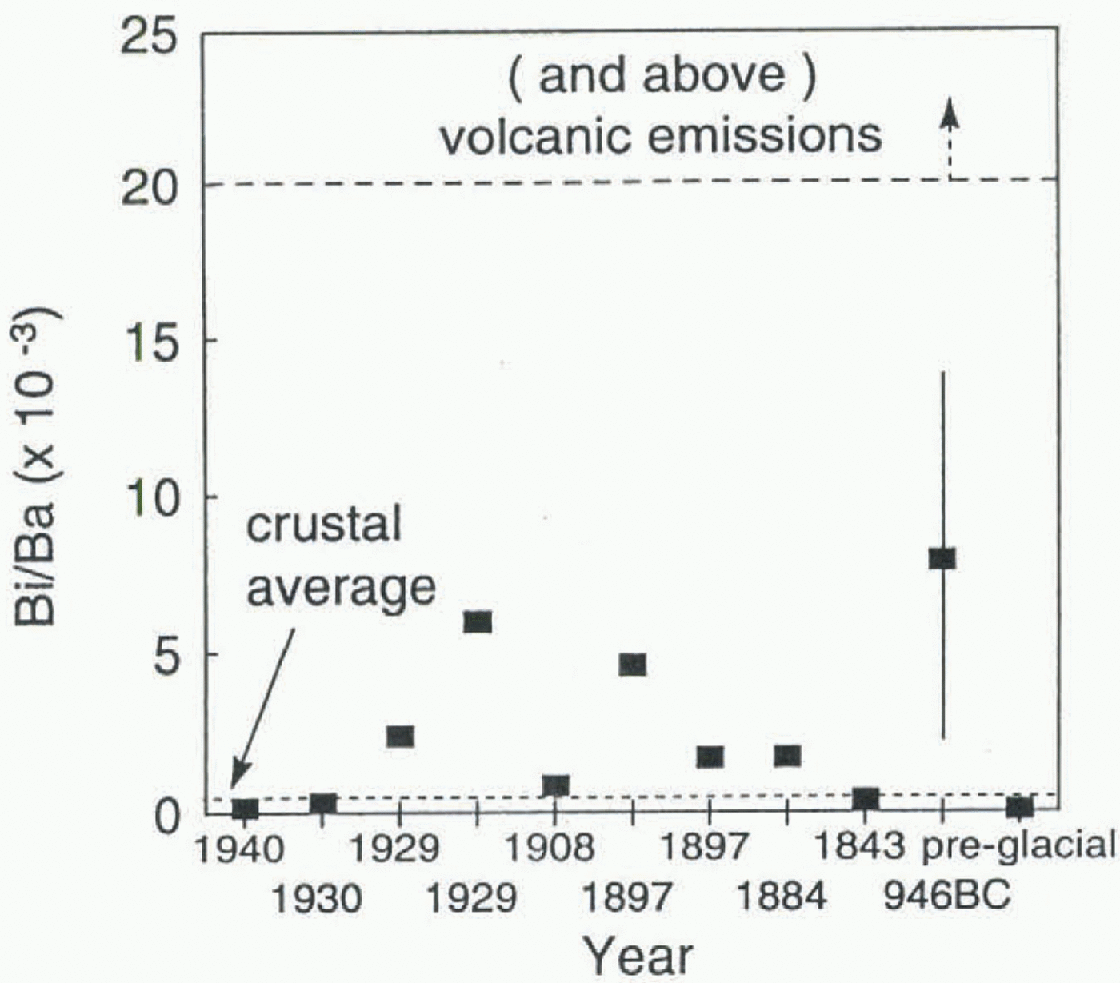Introduction
Field ice-core observations and laboratory annealing tests have indicated that normal crystal growth occurs under constant temperature in unstrained ice (Reference GowGow, 1969). For clean ice, crystal size increases linearly with time (age of the ice) at a rate dependent on temperature. in deforming ice, a number of factors, possibly including stress, temperature, soluble and insoluble impurity levels, temperature at deposition, etc., may affect the crystal growth rate (e.g. Reference Gow and WilliamsonGow and Williamson, 1976; Jacka and Li, 1994). Results from some ice cores have indicated that in layers of ice deposited during different climatic periods with higher impurity concentrations (e.g. ice deposited during the Last Glaciol Maximum (LGM)), crystal growth is inhibited (Reference PatersonPaterson, 1991). It has been suggested that microparlicles (and/or insoluble impurities) are the cause of high shear layers corresponding to the LGM ice in some polar ice cores (e.g. Reference Fisher and KoernerFisher and Koerner, 1986), and several authors (e.g. Reference Koerner and FisherKoerner and Fisher, 1979; Reference Alley, Perepezko and BentleyAlley and others, 1986a, b; Fisher and Koerner, 1986) have suggested that crystal growth may be inhibited by soluble and insoluble impurities through drag effects.
This study is motivated by the desire to obtain a record of crystal size for the ice core from Dome Summit South (DSSi, Law Dome, East Antarctica, for interpretation in terms of palaeoclimate and in relation to the flow properties of the ice. The microparticle concentration record also provides information relevant to past climate. The study of crystal size and microparticle concentration together is prompted by the requirement to understand possible effects of impurities on crystal size and structure. These eilects need to be taken into account in interpretation of either record in terms of palaeoclimate. They also need to be understood in order to improve ice-flow models for the polar ice sheets, particularly in the warm basal layers and the high shear layers.
Sample Preparation
Samples were cut in the field, from the DSS ice core approximately each 6 m between 78 m depth (~ close-off) and the bottom of the core at 1196 m depth. Fach sample was then cut as illustrated in Figure 1. A vertical thin section and a horizontal thin section were cut for crystal-size and orientation measurement. This was done as quickly as possible (usually within 1 hour) after the core was drilled, to ensure minimal crystal-size or structural change from the in situ conditions. For the microparticle concentrations, measure-ment samples need to be uncracked and at least 40 cm long. At least one sample was cut adjacent to the thin sections, scaled in a clean plastic bag and kept frozen for transport to the Coulter-multisizcr/clcan-room facility in Hobart.

Fig. 1. Sketch illustrating the sectors of an ice-cure section used for the different measurements. For the microparticle analysis, one or more uncracked samples ~40 mm long are selected from the section of core.

Fig. 2. Profiles of (a) crystal size, (b) microparticle concentration and (c) δ18O for the DSS ice core. Crystal size is indicated by mean crystal area, measuredfrom horizontal thin sections (full triangles) and vertical thin sections (open triangles). The unit for microparticle concentration is number of particles g−1. Particles with diameters ≥0.506 μm were counted. The age scale and the δ18O profile are from Morgan and others (1987), and the LGM mark and Last Glaciol/Holocene transition mark are inferred from the δ18O profile.
Variation of Crystal Size With Depth and Age
Crystal size was measured from 1:1 scale photographs of ice thin sections. The number of crystals within a specified area of the thin section was counted. One hundred crystals were included in the count area, except at a few depths where large mean crystal area prohibited this. The crystal-size profile for the DSS ice core is shown in figure 2a. An age scale is indicated in Figure 2, interpreted from the δ18O record (fig. 2c) and flow modelling after Morgan and others (1997).
Normal crystal growth (linear increase in crystal area with time) is observed down to ~300m (500 a) at which depth crystal size is 15 mm2 (cf. 1.5mm2 at 78 m (~90a)), indicating a growth rale of ~0.033 mm2 a−1, higher than expected (ice temperature is -21 °C) from Gow (1969). Morgan and others (1997) attributed this higher growth rate to rela-tively high deformation rates in the upper layers as a consequence of the high snow accumulation at DSS.
Crystal growth from 300 to ~1000 m depth is characterised by large fluctuations in crystal size around a gradually increasing trend. Crystal c-axis orientation fabrics show gradual development ofa strong single maximum pat-tern from ~300 to ~700 m depth, and continued strong fabrics from 700 to ~1000 m (Li, 1995).This fabric development is associated with an increase in horizontal shear deformation indicated by borehole inclination measurements (Morgan and others, 1998). A similar trend was noticed in the Byrd core in which Alley and others (1995) found that the average crystal size ceases to increase below 400 m with no obvious change in the temperature, impurity content or crystal orientation fabric.
Borehole temperature measurements (Morgan and others, 1998) show that from ~1000 m to near the bedrock, temperature increases from ra ~14° to -7°C. in this same depth interval, crystal size increases from ~50 to > 1000 mm2, and fabric strength (Li, 1995) decreases. Within this general trend for enhanced crystal growth, there is a narrow band of ice between 1100 and 1140 m depth in which particularly small crystals, strong single maximum fabrics (Li, 1995) and high shear (Morgan and others, 1998) seem associated with other factors. Crystal size is smaller than immediately above, by more than an order of magnitude. Dating and oxygen-isotope measurements (Morgan and others, 1997) indicate that this layer of ice corresponds to the LGM, containing the most negative δ18O values, and it will be seen below that high microparticle concentrations are also found at this depth.
The bottom 50 m of the DSS core is characterised by larger crystals such as reported from several ice sheets and glaciers (e.g. Reference RigsbyRigsby, 1960; Gow and Williamson, 1976; Reference Hooke and HudlestonHooke and Hudleston, 1980; Xie Reference ZichuZichu, 1985; Reference ThorsteinssonThorsteinsson, 1996), corresponding to zones of old ice with low shear deformation rates and high basal temperatures. The basal layer (1195.57 m depth), where the ice contains basal debris and a large amount of visible impurities, exhibits very fine crystals.
Microparticle Concentration
Microparticle concentrations were measured in a class 100 clean room by Coulter multisizer technique. The method for cleaning and measuring ice samples for microparticle analysis was outlined by Reference ThompsonThompson (1977). Samples ~40 cm long are rinsed thoroughly in reagent-grade water, and at least 3 mm of ice is melted from all sides of the sample to ensure removal of possible surface contamination. The Coulter multisizer requires that a saline solution be added to the melted sample to provide a 2% NaCl solution. A 20μm aperture lube is used for the microparticle measurements. To reduce the background noise levels (including electronic noise, and possible contamination from the saline solution and from the cleaning water) to below 10%, only particles with diameters ≥0.506 μm were counted.
figure 2b shows the profile of microparticle concentration for the DSS ice core, based on the measurements of the selected samples. The age span covered by the 40 mm samples can by estimated by reference to the annual layer-thickness diagram presented by Morgan and others (1997). Over the Holoccnc depth interval (<1103m), the microparticle concentration varies from a few hundred to a few thousand g Within this range, however, and despite some variability (possibly due to seasonal cycles), there is some evidence that the dust concentration continued to reduce from the LGM until just 3000 BP (i.e. over the depth interval 1133-900 m), then increased from 3000 to 1000 BP (900 to ~600 m depth).
The most significant feature of the microparticle profile occurs at 1133 m (the LGM) where the concentration of particles is greater by more than an order of magnitude than Holocene and pre-LGM values. It is in this same band of ice that particularly small crystals were noted in the previous section.
Comparison of Grain-Size and Microparticle Concentration
Examination of Figure 2 indicates some possibly related features. While normal crystal growth persists in the upper layers, microparticle concentrations (although there are fewer measurements) show little variation throughout the upper 600 m of the DSS core. Greater variability in the crystal-size profile below 600 m is matched by greater variability also in the microparticle profile. A general trend for increased crystal size with depth below 1000 m is matched by a similar trend for increased microparticle concentrations. On the other hand, the dominant feature of both profiles is a marked spike — decreased values of crystal size, increased values of microparticle concentrations at 1133 m depth, the same depth at which δ18O measurements indicate the LGM.
Figure 3 is a plot of crystal size as a function of microparticle concentration for all of the samples suitable (i.e. uncracked sufficiently large sample, adjacent to a crystal thin-section sample) for both measurements. One data point from an LGM sample from the Greenland Dye 3 ice core is also included. Most of the data indicate no relationship between crystal size and microparticle concentration. However, the six data points with highest microparticle concentration (including the Dye 3 data point) seem to indicate an inverse relationship between crystal size and microparticle concentration.
It seems, then, that crystal growth rate is unrelated to microparticle concentration unless the concentration is above some “threshold” value (~104g−1). Above this concentration, crystal growth is retarded to a greater degree, the higher the concentration. This result is independent of the climatic origin oft he ice. Figure 3 includes one Dye 3 and four DSS LGM samples and one DSS Holocene sample above the “threshold” value for which the crystal-growth-microparticle-concentra-tion relation holds. Below the “threshold” value are the bulk of the DSS Holocene samples, but also two samples from the beginning of the last Glaciol period.
A similar result to that found here was found for the Agassiz 77 core by Fisher and Koerner (1986) who concluded that an inverse relationship existed between crystal size and microparticle concentration, given that microparticle concentration was greater than 1.5 X 104g−1. Alley (1986b) argued that crystal growth is restricted by micro-particles only when particle concentration is sufficiently high that the ice becomes discoloured.
Due to the high snow-accumulation rate at DSS, the microparticle concentrations for this core are lower than for most other polar ice cores. For the Dome C, Antarctica, ice core, Reference Duval and LoriusDuval and Lorius (1980) found that the Holocene microparticle concentrations were 104g−1, similar to the “threshold” value found in Figure 3. Duval and Lorius argued that insoluble impurity content did not affect crystal growth. Reference Petit, Duval and C. LoriusPetit and others (1987), on the other hand, suggested, from Dome c and Vostok core data, that crystal growth rate is driven by surface temperature at the time of deposition. On the basis of the results found here, we cannot exclude the possibility that microparticles (or soluble impurities) influence the LGM crystal size for the Dome c ice core. Neither would we eliminate the effects of flow on the Dome c LGM crystal size, even at the relatively shallow depth of 400 m.
We have seen above thai crystal-orientation fabric slrength and horizontal shear in the DSS ice core also vary with crystal size and with microparticle concentration. We have also commented on the relationship between crystal

Fig. 3. Crystal mean area plotted as afunction of microparticle concentration. Data represented by squares are from DSS samples with in the Holocene depth interval. Solid triangles represent DSS LGM samples, and circles represent samples from the beginning of the last Glaciol period. The cross is a datum from a Dye 3 LGM sample.

Fig. 4. Photographs and c-axis fabric diagrams for each test sample, showing crystal textures and fabrics at the beginning (left column) and conclusion (right column) of mnealing tests. Sample depth, crystal size before and after test, microparticle concentration and annealing duration time are indicatedfor each sample. Annealing tests were performed at a constant temperature of -1.0°C.
size and ice flow. in fact, for the data of Figure 3 with microparticle concentrations below the “threshold” value, we suggest that the variability in crystal size is due to variations in the flow. For microparticle concentrations above the “threshold” value, the crystal size is also affected by the ice flow as well as the microparticlcs. While Figure 3 illustrates the microparticle effect on crystal size, it takes no account of the possible effects associated with the flow of the ice. To separate the elfects on crystal growth of the microparticles from those of the flow, a set of laboratory annealing experiments was carried out.
Annealing Experiments
A set of annealing tests was performed at a temperature of -1.0 C. Five samples were tested. Three Holocene samples and one sample from the LGM were selected from the DSS core. One sample (with much higher microparticle concentration) was selected from LGM ice in the Dye 3 ice core. The test samples were selected to initially exhibit, as nearly as possible, similar physical properties — initial crystal size was similar and each sample had a strong single-pole crystal-orientation fabric — but a large range of microparticle concentration. Thus, the effect of microparticle concentration on crystal growth rates was able to be examined under no stress and independently of any crystal-orientation fabric effect. Figure 4 provides thin-section photographs and crystal-orientation fabrics for each of the samples prior to the annealing period and after the tests were concluded.
Each test sample was sealed in a plastic bag and immersed in a bat h of silicone oil. The bath was located in a freezer box at ~-20°C and bath temperature controlled to -1.0°C using heating elements. Variations in test temperature were <0.01 °C After different time intervals, samples were removed from the bath, and thin sections cut for crystal studies. The remaining sample was then replaced in the bath for further annealing. The crystal growth rates resulting for each of the five tests are indicated by the thin-section photographs and (hila of Figure 4 and by the slopes of the lines of Figure 5. It is seen that for these high-temperature conditions and under no stress, ice with initially small crystals and strongly anisotropic fabric (formed in situ by deformation to high strains) changed so that the mean crystal size increased and the fabric central tendency weakened. However, this process is highly retarded for samples with high microparticle concentration. The Dye 3 sample exhibited zero crystal growth over the 170 day test period, and the dirtiest DSS sample only a doubling in crystal size in the same period (cf. the clean samples exhibiting a 20-fold size increase in 90 days). Also, the crystal-orientation fabric strength for the Dye 3 sample was unaffected, the strong single pole persisting through the annealing period.
The laboratory tests thus confirm the conclusion from the DSS ice-core results, that microparticlcs do not retard crystal growth unless the concentration is ≥104g−1. They also indicate that the retardation of crystal growth for the LGM ice is primarily affected by the high microparticle concentration.
It has been found for several of the ice cores retrieved from polar ice sheets that concentrations of soluble and insoluble impurities tend to vary together. For example, the Dye 3 ice core exhibits increased levels of soluble and in-soluble impurities for the LGM ice (Reference Dahl-Jensen and GundestrupDahl-Jensen and Gundestrup, 1987), and the Agassiz 77 ice core shows particularly high values of soluble and insoluble impurities varying together (Fisher and Koerner, 1986).
As Yet, we have been unable to separate the individual effects of the different impurities on the crystal size and structure or ice-flow properties (see, e.g. Paterson, 1991). At this stage, it is therefore not conclusive that the dependence of crystal size found above is on microparticle concentration; i.e. crystal growth maybe retarded, not by high microparticle concentrations, but by high concentrations of some other impurity which varies with microparticle concentrations. Work is continuing in the laboratory to unravel this dilemma.
Conclusion
We have presented results of an investigation of crystal size and variation of microparticle content in the DSS ice core, in conjunction with the results from laboratory annealing experiments on ice with different impurity levels. They indicate that for ice with very low impurity concentrations, including most of the ice deposited during the Holocene (<1103 m depth), variations in crystal size are not related to variations in microparticle concentration. For the ice containing concentrations of microparticles an order of magnitude higher than the Holocene ice, i.e. ice deposited during the LGM, and in the basal silty ice in which impurity concentrations are extraordinarily high, crystal growth is retarded, and measured crystal sizes are small.

Fig. 5. Plot of crystal mean area as a function of time for annealing tests, showing impurity effect on crystal growth rate. The number beside each solid line in the diagram indicates the microparticle concentration for the sample.
Acknowledgement
We tank the Niels Bohrs Institute, University of Copenhagen, for providing the Dye 3 ice sample.







